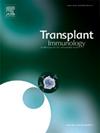他克莫司治疗范围时间(TTR)对移植后早期预后的影响。
IF 1.6
4区 医学
Q4 IMMUNOLOGY
引用次数: 0
摘要
他克莫司是异基因干细胞移植(AlloSCT)后免疫抑制的主要药物。没有足够的动力学数据证明维持治疗水平的一致性。在此,我们测量了治疗范围动力学(TTR)及其对同种异体移植结果的影响。我们的本地观察队列包括2012年1月至2019年12月在澳大利亚医院进行的186名成人同种异体移植。另外一个外部队列包括来自犹他大学的307名接受同种异体细胞移植的成年患者。我们将足够的TTR定义为在移植后的前30 天内,在5.0和15.0 ng/mL之间的测量值中占bbb75 %。在我们的本地队列中,55% %的患者具有足够的TTR值。足够的TTR患者的原发性移植物衰竭显著降低(2 %,95 % CI 0.5-7.7 % vs. 10 %,95 % CI 5-18 %,p = 0.01)。适当的TTR显著降低了非复发死亡率(NRM)(17 %,95 % CI 11-26 % vs. 33 %,95 % CI 24-43 %;p本文章由计算机程序翻译,如有差异,请以英文原文为准。
Impact of tacrolimus time in therapeutic range (TTR) on early post transplantation outcomes
Tacrolimus is a backbone for immunosuppression after allogeneic stem cell transplantation (AlloSCT). There is no sufficient kinetic data demonstrating the consistency of maintaining therapeutic levels. Herein, we measured the kinetic of therapeutic range (TTR) and its impact on outcomes of AlloSCT. Our local observational cohort included 186 adult AlloSCT performed at Hospital Austral between January 2012 and December 2019. An additional external cohort included 307 adult patients with AlloSCT from the University of Utah. We defined adequate TTR as >75 % of the measurements between 5.0 and 15.0 ng/mL during the first 30 days post-transplantation. In our local cohort, 55 % of patients had adequate TTR values. Primary graft failure was significantly lower in patients with adequate TTR (2 %, 95 % CI 0.5–7.7 % vs. 10 %, 95 % CI 5–18 %, p = 0.01). Non relapse mortality (NRM) was significantly lower with adequate TTR (17 %, 95 % CI 11–26 % vs. 33 %, 95 % CI 24–43 %; p < 0.01). Similarly, the external cohort had an NRM value significantly reduced in patients with adequate TTR values. In the pooled data analysis of local and external groups (n = 493), the TTR value below minimal range (≥25 % of measurements <5 ng/mL) was an independent risk factor for graft failure, as well as for NRM rate (44 %, 95 % CI 30–57 % vs. 18 %, 95 % CI 15–22 %) (p < 0.001) and lower OS at 3 years (47 %, 95 % CI 26–55 % vs. 56 %, 95 % CI 49–59 %, p < 0.001).
These findings showed the importance of adequate TTRs during the first month after AlloSCTs. Sub-therapeutic TTR values were associated with worse survival outcomes.
求助全文
通过发布文献求助,成功后即可免费获取论文全文。
去求助
来源期刊

Transplant immunology
医学-免疫学
CiteScore
2.10
自引率
13.30%
发文量
198
审稿时长
48 days
期刊介绍:
Transplant Immunology will publish up-to-date information on all aspects of the broad field it encompasses. The journal will be directed at (basic) scientists, tissue typers, transplant physicians and surgeons, and research and data on all immunological aspects of organ-, tissue- and (haematopoietic) stem cell transplantation are of potential interest to the readers of Transplant Immunology. Original papers, Review articles and Hypotheses will be considered for publication and submitted manuscripts will be rapidly peer-reviewed and published. They will be judged on the basis of scientific merit, originality, timeliness and quality.
 求助内容:
求助内容: 应助结果提醒方式:
应助结果提醒方式:


